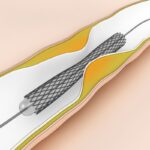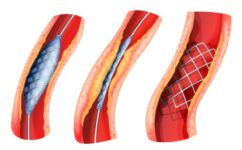Original title: Post-procedural aortic regurgitation in balloon-expandable and self-expandable TAVR procedures: analysis of predictors and impact on long-term mortality: insights from the FRANCE 2 registry. Reference: Van Belle E et al. Circulation. 2014; Epub ahead of print. This study used transthoracic echocardiography (TTE) to evaluate 2769 patients undergoing successful TAVI in 34 centers in France, enrolled in…
Predilation with smaller valvuloplasty balloon diameter could reduce the need for permanent pacemaker after CoreValve
Original title: Reduction of pacemaker implantation rates alter CoreValve implantation by moderate predilatation Reference: Philipp Lange, et al. EuroIntervention 2014;9:1151-1159 Aortic valve implantation has been proven a valid strategy to treat high risk patients. The CoreValve self-expanding transcatheter aortic valve is associated with a relatively high rate of permanent pacemaker implantation and, until now, no efforts have been…
Best results of angioplasty with DES guided by IVUS versus angiography only
Original title: Intravascular Ultrasound-Guided Implantation of Drug-Eluting Stents to Improve Outcome. A Meta-Analysis. Reference: Jae-Sik Jang et al. J Am Coll Cardiol Intv 2014, epub ahead of print. Several previous studies and meta-analysis showed that implantation of conventional stents (BMS) intravascular ultrasound (IVUS) guided may decrease restenosis and clinical events. This information was not yet clear to drug-eluting…
At least one month of antiplatelet seems sufficient after a zotarolimus -eluting stent
Original title: Lack of association between dual antiplatelet therapy use and stent thrombosis between 1 and 12 months following Resolute zotarolimus-eluting stent implantation. Reference: Silber S, Kirtane AJ, Belardi JA, et al. Eur Heart J. 2014; Epub ahead of print. Dual antiplatelet aggregation optimal time after implantation of a new generation drug-eluting stent (DES) is still discussed. This…
The length of the stent is not an event predictor with the new generation of DES. It is the end of the Spot stenting?
Original title: Impact of the Stent Length on Long-Term Clinical Outcomes Following Newer-Generation Drug-Eluting Stent Implantation. Reference: Ik Jun Choi et al. Am J Cardiol 2014;113:457-464. Completely cover the lesion with a sufficiently long stent has been the preferred strategy that emerged from drug-eluting stents (DES). However, for the first-generation DES stent length has been a predictor of…
Currently a patient receiving angioplasty is more likely to die from non-cardiac causes
Original title: Trends in cause of death after percutaneous coronary intervention. Reference: Spoon DB et al. Circulation. 2014; Epub ahead of print. This retrospective study evaluated the specific cause of death in 19077patients who received angioplasty in a center between 1991 and 2008. To perform the analysis, the track was divided into three time periods: 1991-1996, 1997-2002,…
Hybrid revascularization versus conventional surgery. Advantages and disadvantages for choosing ideal patients.
Original title: Clinical Outcomes after Hybrid Coronary Revascularization versus Coronary Artery Bypass Surgery: A Meta-Analysis of 1,190 Patients. Reference: Ralf E. Harskamp et al. American Heart Journal (2014), epub ahead of print. Hybrid revascularization combines long-term patency of the mammary artery connected to the left anterior descending with minimally invasive drug-eluting stents to other injuries. This in…
Endovascular treatment in critical limb ischemia, better permeability with similar mortality and amputation than surgery.
Original title: Comparative effectiveness of endovascular and surgical revascularization for patients with peripheral artery disease and critical limb ischemia. Reference: W. Schuyler Jones et al. American Heart Journal 2014. Epub ahead of print. Critical limb ischemia is the most severe condition affecting patients with peripheral vascular disease. Mortality, morbidity, and costs associated with this condition are…
3rd generation zotarolimus-eluting stent non- inferior to everolimus
Original title: Third-generation zotarolimus-eluting and everolimus-eluting stents in all-comer patients requiring a percutaneous coronary intervention (DUTCH PEERS): a randomized, single-blind, multicentre, non-inferiority trial. Reference: Von Birgelen C et al. The Lancet. 2014; Epub ahead of print. In the 3rd generation zotarolimus-eluting stent, platform was modified to increase flexibility and make implant easier in complex lesions. This study was…
Percutaneous closure versus surgical of the perimembranous interventricular communication
Original title: Transcatheter versus Surgical Closure of Perimembranous Ventricular Septal Defects in Children: A Randomized Controlled Trial. Reference: Jian Yang et al. J Am Coll Cardiol. 2014; Epub ahead of print. The ventricular septal defect (VSD) is the most common congenital heart disease, and perimembranous being the most common variant. In countries like USA surgery is considered…









